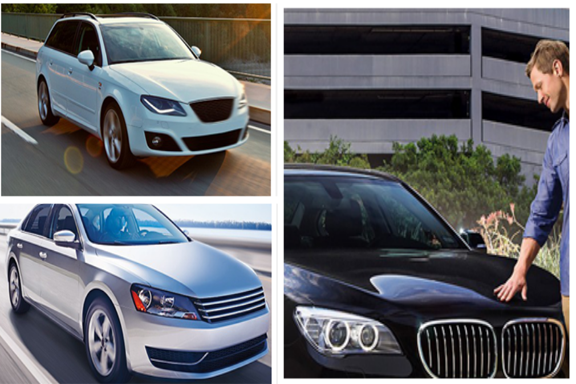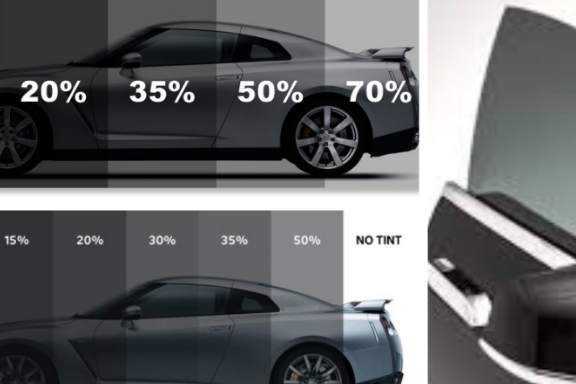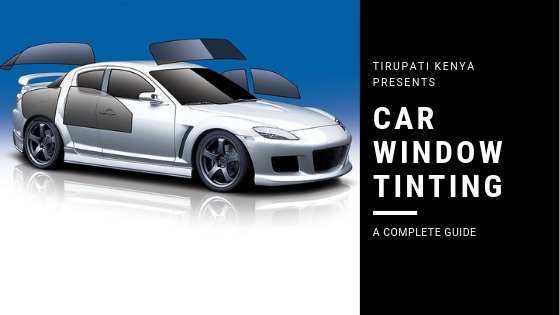Whether you drive in a sedan, coupe, SUV or city car, you can be tempted to put tinted films on the windows of your car. The fact of obscuring the windows brings a lot of positive points, but also some negative aspects if we do it wrong.
Tinted Car Winscreen Types, Laws & Benefits
This desire for comfort can be explained by the awareness that took place several years ago concerning health. Because comfort keeps you healthy that’s why
Tirupati Kenya improves your comfort every day, thanks to its tinted film for cars.
Why choose Tirupati Kenya
automotive tinted films ?
What is the point of having tinted windows? We explain to you!
Currently,
car window tints in kenya is used on vehicles, whether private or professional, but do you know why?
The installation of protective film on your personal car or on your construction equipment brings a lot of advantages.
First, the tinted windows protect your equipment because, by filtering the UV, it protects the entire interior of your cabin:
- Your leather remains intact
- Your plastic and other valuable does not get ruined under the sun and stays protected
- Also, tinted windows help prevent the risk of overheating your vehicle, whatever it may be, while maintaining a pleasant temperature. In winter, they keep the heat inside of your vehicle
There is also a security aspect to take into account. The film placed on your window protects you in case of an accident, against the glass shards which would, in normal cases of crisis will remain glued to the film.
Also read – Car Window Tinting Kenya – Benefits & Reasons to Tint
Types of Car Window Tint in Kenya

However, not all types of window tinted films are as effective at achieving above mentioned goals. That is why it is worthwhile trying to consider the basic categories of tinted window films.
There are actually a few main types of films, which differ in the quality of their materials, their efficiency and their cost.
How do you choose among them?
Dyed Window Film for Vehicles
Tinted Film is the most economical type of tinted window film – the least expensive and a little less functional than the others – blocks light rays by adding a dye to the film; the dye is placed in a layer next to the adhesive and then applied to the window.
Solar heat is absorbed by the dye in the film, thus preventing some of the heat from penetrating through the window. However, tinted window film is mainly used for appearance.
From the outside, the tinted film seems flat and opaque, offering some privacy while allowing visibility from the inside; when used on the windows of an automobile, it will appear in black.
The dye tends to fade over time, however. The heat reduction provided by most varieties of dyed films is not particularly high.
The Metallic Car Window Tint Film
It is like the dyed film, removes the heat from the inside by reflecting it; in the case of a metallized film, this is done by very small metallic particles – invisible to the eye – embedded in the film.
This metallic content also reinforces the window; in the case of a vehicle, the glass will be more resistant to shocks when using a metalized film.
The tinted film for metallized window creates a shiny appearance from the outside. It is more scratch resistant than the dyed film. When used in a vehicle, however, a metallized film has the disadvantage of being metalic and tends to interfere with the transmission of the mobile phone and the GPS signals, not to mention the radio reception.
Carbon Tinted Film for Kenyan Cars
Carbon tinted window film gives rather better results. The carbon film does not contain metal. The problem of mobile phones and radio transmission does not arise when it is used.
The carbon film for windows is dark and matte, making it a good option for windows. The carbon content of the film blocks about 40% of the infrared light (the one that produces the heat) that penetrates through the windows.
Carbon window dye film is as effective as other varieties in blocking heat; its use will effectively cool interior spaces while preventing discoloration of furniture.
Thus, the air conditioning will not require as much work to cool the space in summer, any more than the heating system will suffer such a significant impact in winter. Unlike dyed films, carbon films will not fade over time.
Oem Tinted Glass Window in Automotive
This type of dye is actually integrated into the windows. This shade is also limited, which means that darker windows that block more heat and UV rays will not be the result of OEM dyeing.
If you want something strong, do not choose this one.
Ceramic Window Tint Film for Cars
Ceramic film is the highest quality of glass film, and the most expensive contains no metal, colorant or carbon, but rather a kind of ceramic particle both non-conductive and non-metallic.
Ceramic film has only recently appeared on the market, but it has already proven itself in terms of performance and reliability.
Tinted glass ceramic film absorbs 45% to 50% of the solar heat entering through the windows as infrared light, while allowing maximum visibility day and night.
Like carbon films, tinted glass ceramic films allow maximum efficiency in the operation of radios, mobile phones, GPS systems and all other such devices operated from within the protected area.
It outperforms other types in its resistance to glare and fading and makes windows highly shatterproof. The ceramic film is also very effective in blocking ultraviolet rays from the inside; in the case of ultraviolet light (the kind of light rays that contribute to sunburn and skin cancer), a ceramic film for tinted windows can block up to 99% of penetrations indoors.
Infrared Window Film in Automotive
It blocks the same amount of heat and UV rays as other types of tints, but it has very high visibility. This means that the windows are not too dark, which is perfect for states with strict window film rules.
Infrared films are also designed not to fade, so they should last a long time without peeling off or tearing.
Also read – Choose The Right Car Window Film To Reduce Heat And Glare
Top Benefits of Getting Your Car Windows Tinted

Tinted windows are ideal for keeping a certain intimacy. Not only you will be able to drive quietly without being seen, but opting for glass filming allows you to leave your bags or valuables in your car without the risk of attracting thieves who cannot distinguish what is present inside your cockpit.
- Solar film to avoid the discoloration of the fabrics of your seats
The solar film on car windows makes it possible to block 99% of the UV, that is thus all the fabrics, the leather and the lining of your car which are protected from sun attacks. Your skin will also thank you by suffering less from the harmful effects of UV when riding.
- Film on the glass for the aesthetics of your vehicle
There is a multitude of models and colors for the installation of film on glass for vehicles. This operation is quick to put in place, the film is cut to the size of your windows and the investment is very cheap. You can change the style of your car according to the seasons and your desires for the moment!
- Laying film on windows to fight against the heat in the cabin
There is evidence that opting for a solar film on your windows reduces the heat. Ideal for the summer and in fairly warm areas where you will realize significant savings of gas using very little air conditioning. Guaranteed driving comfort and it’s an eco-friendly gesture for the planet!
- Optimize your safety thanks to a film installation on the glass
During a glass break, an
accident or an attempted break-in, having a film affixed to the glass keeps all the pieces of glass together and avoids splashing inside the cabin. The glass is stronger and will protect you more effectively from external aggression.
- Some additional advantages of tinted window films
You will be safe from police officers if you use your cell phone illegally or forget your belt. However, this advantage is a disadvantage since the use of a mobile phone while driving greatly increases the risk of accident and without the safety belt you can become unconscious.
Also read – Safety Films for Protection From Burglary and Car-jacking
Car Windscreen & Window Tinting Laws in Kenya
To be clearer, the rules should indicate the reflectance and transmittance limits of the glass. In other words, how much light must pass through the glass and what is the maximum allowed to reflect in Kenya?
We have seen similar rules from a different country and they said that the glass should allow at least 35% of light to pass through and should not reflect more than 21%. It’s something that can be scientifically tested, but it’s not perfect either.
What light speaks the law? Green, yellow, red or blue? The so-called colorless white light includes all the colors of the rainbow. And they are not seven! They are infinite in number.
That’s why a car gets very hot inside when exposed to the sun. It is also the operating principle of a greenhouse. Once the sun enters the interior, it is absorbed by the objects it contains, as a result, they warm up and emit an infrared “light”.
More than 50% of this infrared is returned to the car by the glass. He is therefore trapped and can not go out. As a result, the car continually accumulates heat and becomes much hotter than its surroundings.
Bearing in mind these technical details, a good lawyer can argue in court that the rules regarding reflective tints and windows of cars are unclear and are therefore difficult to meet. It would be desirable for the Department of Transport Kenya, to review the rules before coming to this point.
First of all, it goes without saying that the tinted film on the windshield is both totally forbidden and very dangerous. Regarding the rear windows, you have no obligation, you can tint with a heavy hand.
What Percentage of Tinted Film Is Legal?

Each state or county is able to define its own laws on an allowable shade limit. The generally accepted limits are 50% for the driver’s and passenger’s front window and 35% for the rear passenger or the side windows and the rear window.
50% of the tint prevent the available light from reaching the interior of the car. It is a great option to block heat and ultraviolet rays.
Thirty-five percent shade is the maximum allowed by the laws of many states.
- 20% of the shade of the window
The tint of the window at twenty percent is also called “Factory Tint”. Windows tinted at the time of manufacturing of the car usually have a tint of 15% to 26%.
5% of shade is also called “Limo Tint”. This shade only allows in 5% of the available light.
Now you know
tinted car windows types & laws in Kenya . As of now you better understand, tinting automotive windows is also reduce the risk of overheating and brightness in your car.
So you can fully enjoy your interior comfortably. For more information, do not hesitate to
contact us, expert in the field and present throughout the region of Kenya.




